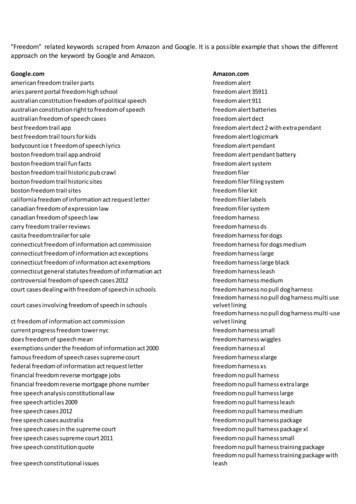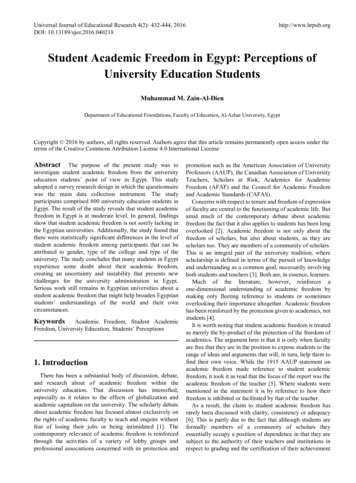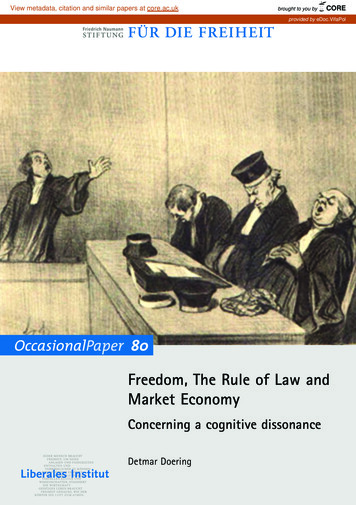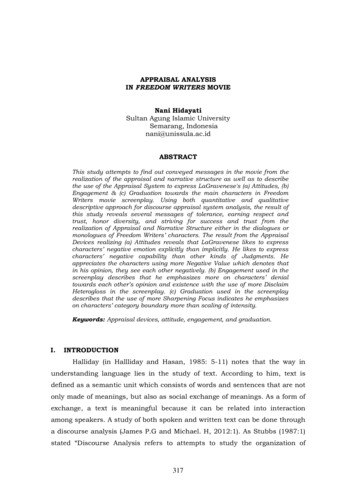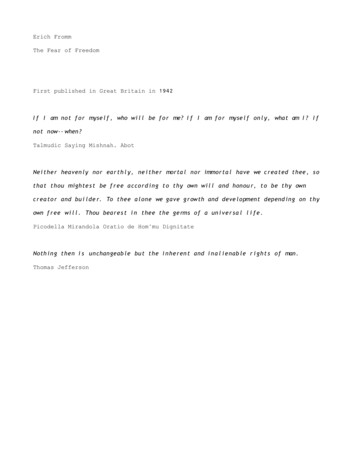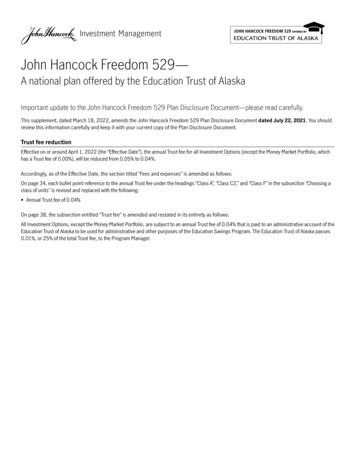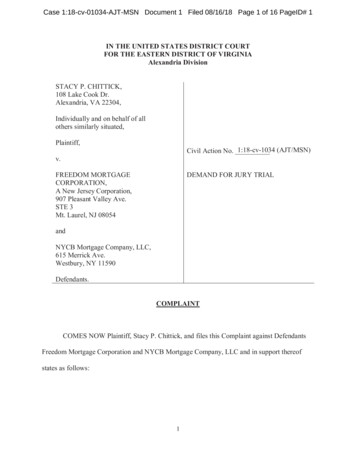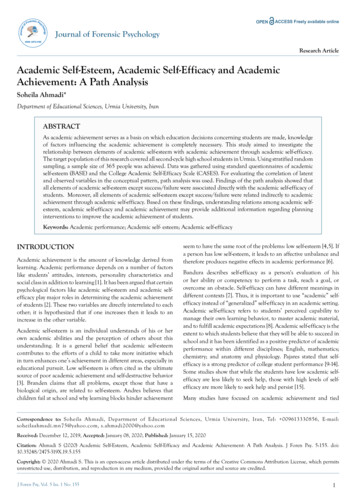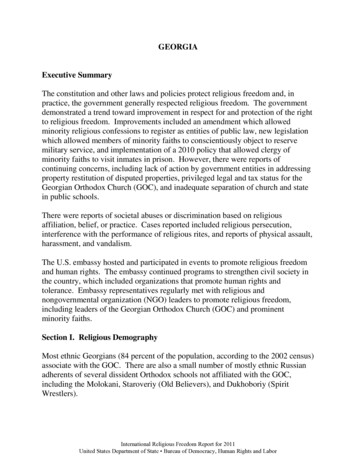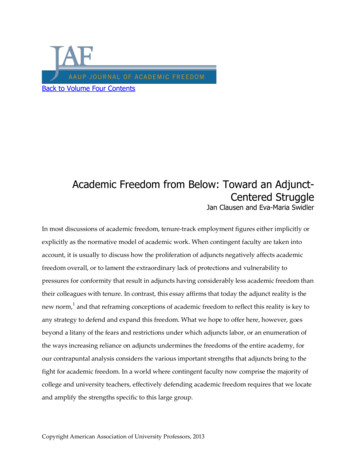
Transcription
Back to Volume Four ContentsAcademic Freedom from Below: Toward an AdjunctCentered StruggleJan Clausen and Eva-Maria SwidlerIn most discussions of academic freedom, tenure-track employment figures either implicitly orexplicitly as the normative model of academic work. When contingent faculty are taken intoaccount, it is usually to discuss how the proliferation of adjuncts negatively affects academicfreedom overall, or to lament the extraordinary lack of protections and vulnerability topressures for conformity that result in adjuncts having considerably less academic freedom thantheir colleagues with tenure. In contrast, this essay affirms that today the adjunct reality is thenew norm,1 and that reframing conceptions of academic freedom to reflect this reality is key toany strategy to defend and expand this freedom. What we hope to offer here, however, goesbeyond a litany of the fears and restrictions under which adjuncts labor, or an enumeration ofthe ways increasing reliance on adjuncts undermines the freedoms of the entire academy, forour contrapuntal analysis considers the various important strengths that adjuncts bring to thefight for academic freedom. In a world where contingent faculty now comprise the majority ofcollege and university teachers, effectively defending academic freedom requires that we locateand amplify the strengths specific to this large group.Copyright American Association of University Professors, 2013
AAUP Journal of Academic FreedomVolume Four2In advocating for this effort, we acknowledge that, despite vigorous and rising activismamong contingent faculty—work that has spawned such advocacy organizations as the2Coalition of Contingent Academic Labor (COCAL) and the New Faculty Majority —academicfreedom has so far ranked low on the list of vocally pursued adjunct concerns. This is notsurprising, given the pressing economic and labor issues contingent faculty face daily. Adjunctshave had more immediate issues to address than the impact of their status on academicfreedom, even as tenured and tenure-track faculty have largely failed even to acknowledge themagnitude of the problem. This article, then, calls on both faculty groups to prioritize the threatposed to academic freedom by the reality of a majority-adjunct academy.We should open our brief description of the consequences of the academic unfreedom ofnon-tenure-track faculty with a few definitions and statistics. Although in this article we refermost frequently to “adjunct” faculty, the salient features of adjuncts’ working conditions tend toapply to contingent faculty in general. Despite differences and particularities, the inherentinsecurity of contingent appointments makes for a foundational similarity across categories.All observers agree that the numbers of contingent faculty are massive and growing,although data collection problems and a variety of methods yield slightly varied statistics; forinstance, the category of “teachers” in institutions of higher education includes teachingassistants, who may not be included in statistics labeled “faculty.” Reflecting the lack ofinstitutional attention to contingent faculty issues, the June 2012 report of the Coalition on theAcademic Workforce relies on data from the US Department of Education’s 2009 Fall StaffSurvey as the most recent and best available information on the prevalence of contingent labor,as does the AAUP’s 2013 report on contingent faculty and governance. According to these data,of all teachers in degree-granting two- and four-year institutions of higher education in theUnited States, 75.5 percent were employed in contingent positions off the tenure track. Thiscategory of “contingent” includes part-time or adjunct faculty members, full-time non-tenuretrack faculty members, and graduate student teaching assistants.3
3Academic Freedom from BelowJan Clausen and Eva-Maria SwidlerPart-time or adjunct faculty are by far the largest subset of all higher education faculty andconstitute a strong majority (70%) of contingent faculty,4 forming roughly half of college anduniversity faculty and 40 percent of all teachers (the category that includes teaching assistants)employed in higher education. In this article, we have chosen to focus on adjuncts as the clearlydominant contingent category, while bearing in mind that the contingent faculty who togethermake up three-quarters of the overall professoriate typically labor under roughly sharedconditions of precarity. We have chosen to foreground adjuncts among the contingent facultynot only because of their numbers but also because adjuncts, we argue, serve as the defaultcontingent category. Contingent full-time faculty frequently emerge from among part-timeteachers and return to their ranks again, once their appointments have run their course, whileteaching assistants’ positions are time-limited by definition. The staggering statistics reflectingthe rise and expansion of precarious academic labor, considered in light of the vulnerabilityendemic to this employment category, raise haunting questions about the academy and itscherished principles and, perhaps, cherished myths. Those questions come into sharper focus aswe take a closer look at the implications of the new adjunct norm for the range of waysacademic freedom is typically described.From a perspective that views academic freedom as the sum of the freedoms of individualfaculty members, we may ask: if three-quarters of higher education faculty today arecontingent, is it meaningful any longer to talk of academic freedom as a ruling principle inhigher education? Or is it incumbent on us to consider that the conditions and constraints whichare the constant context of this great majority of academics are the new reality of highereducation? Rather than framing our battle as the defense of some regnant, if threatened,standard of unfettered intellectual activity, perhaps we would do better to frame our struggle asone to establish academic freedom for that large proportion of scholars and teachers for whom itcan scarcely be said to exist.We would do well, however, to temper this individual-based approach with a moreexpansive view, given that, as Benjamin Johnson has eloquently argued, “free speech is not only
AAUP Journal of Academic FreedomVolume Four4an attribute attached to individual academics (or anybody else), but rather necessary to maketeaching and research actually serve a purpose beyond the gratification or advancement of5whoever’s performing it.” If we conceive of academic freedom not merely as the ability of eachfaculty member to teach, research, and publish fearlessly but also as the collective freedomenjoyed by the faculty bodies charged with guiding the pedagogical and intellectual life ofeducational institutions, what becomes of that freedom if the vast majority of faculty memberscannot exercise their collective functions without fearing employer retribution and in fact all toofrequently find themselves excluded from participation in the normal structures of governance?How will such divided and largely disenfranchised bodies manage to set appropriate standardsof pedagogy and scholarship, to formulate the general goals and purposes of higher educationin terms specific to given institutions, and to make the fearless and imaginative decisions aboutmatters including hiring, program design, and pedagogy that will surely be required to realize6those ends? We can approach our task realistically only when we begin to frame it in terms ofestablishing the freedom of the entire faculty to govern academics matters.Finally, if we define academic freedom as including not only the traditional triad of freedomin the classroom, in research, and in governance but also the freedom of so-called extramuralspeech—the right and responsibility of knowledge workers to speak freely, and on occasiondissentingly, in the public forum, on issues of importance to all citizens7—can we really say thatmost faculty members have that right or freedom? When most of them risk forfeiting renewal oftheir teaching contracts if they dare to advise a group of student activists or speak criticallyabout the university administration to an inquiring journalist, it seems that we are not so muchpreserving as endeavoring to establish the right of academics to act as public intellectuals.In short, at a time when contingent (or as one author devastatingly and accurately calls8them, “disposable”) academic laborers form the overwhelming majority of faculty members,discussions of academic freedom need to take the adjunct reality of unfreedom as the baselinereality of academia. Additionally, without academic freedom in the classroom or in research forthe multitude of individual adjuncts and other contingent faculty, there can also be no powerful
5Academic Freedom from BelowJan Clausen and Eva-Maria Swidleracademic community or unified academic voice.9 To effectively grapple with these dangers andadvocate for meaningful academic freedom, discussions of the topic will need to engageconcretely with the bitter truth that the contingent status of a majority of faculty now constitutesthe only realistic point of departure.10As an aside, we would like to acknowledge two dynamics of academic transformation, eachof which merits a level of detailed analysis that we have not attempted here. Not coincidentally,both are directly linked to the push for expanding use of contingent faculty, and both raisepivotal issues concerning academic freedom.The first of these is for-profit higher education, a powerful and growing area of academiathat brings the process of marketization to its logical conclusion. Just about every feature oforganizational transformation that threatens academic freedom is exaggerated to its extreme inthe profit-driven landscape, including the use of an essentially one-hundred-percent contingent11faculty in for-profit universities. When we consider the trend toward an ever more contingentfaculty in nonprofit institutions in light of a total picture that includes schools run to make aprofit, we can more clearly identify the proliferation of adjunct employment as reflecting adeliberate effort to make higher education conform to a corporate business model.A second key development that we can mention only in passing is the proliferation of onlineeducation schemes. Online instruction is clearly linked, though not limited, to the expansion ofboth stand-alone for-profit institutions and the for-profit spin-offs that many private institutionsare undertaking.12 With an almost franchise-like model of prefabricated syllabi, “contentdelivering” faculty, intellectual standardization, and electronic surveillance, this model at itsworst epitomizes a corporate approach to higher education and, not surprisingly, appears torely heavily on contingent faculty labor. (We are not aware of any formally compiled statisticson contingent faculty and online courses other than the US Senate report cited in note 11.)13 Weare left with three stark alternatives: to simply give up, to mount a cynical rearguard action indefense of the remaining elite tenured jobs, or to confront the conditions faced by the contingentmajority, drawing insights and energy from their ranks. What might those adjuncts say? What
AAUP Journal of Academic FreedomVolume Four6can they contribute? Speaking as two members of the academic precariat, we offer the followingfive propositions in hopes that others will be inspired to step forward as well.First of all, faculty members who have directly experienced the consequences of exclusion fromtenure-track employment often understand with crystal clarity that the traditional model is not comingback—an understanding without which, we argue, there will be no real push for meaningful alternatives.Appeals to restore the tenure system to a status sufficiently robust to underwrite guarantees ofacademic freedom for all are every bit as unlikely to succeed as ringing calls for corporations torepatriate offshored jobs and revert to Fordist compensation structures as a means of rebuildingAmerica’s industrial job base.In other words, contemporary academic reality has everything to do with globalization,understood not merely as the movement of people and employment across national borders butprimarily as the concrete manifestation of a neoliberal ideology that has colonized the educationfield with its shrill and ubiquitous demands for flexibility, efficiency, instrumentality,marketability, and customer satisfaction. “Globalization” is not just about US students wantingto study Mandarin, or about NYU opening a campus in Abu Dhabi. “Globalization” is therationale, the discursive disciplining mechanism, for a curriculum that is all about credentials ina context in which creative thought is understood to be a frill. “Globalization” is why the facultywill not be heard when we object to this approach to education. How dare we prioritizeanything other than our students’ chances of success in a ruthless international job market?“Globalization” is how transnational capital is transforming education to abolish the temporaryautonomous zones of the knowledge economy in favor of a certification industry.14 Above all,this ideology disciplines, shrinking the horizons of students, teachers, and administrators alikewith a relentless logic that, once its premises are accepted, implicitly justifies the vanishingfreedoms and debilitating economic insecurity experienced throughout academia.The most powerful international financial institutions have taken an active role inpromoting this shrinkage. In a 2002 article, Les Levidow discusses the roles of the World Bank,the International Monetary Fund, the World Trade Organization, the European Union, and
7Academic Freedom from BelowJan Clausen and Eva-Maria Swidlerothers in a campaign to restructure (or, as he names it, “marketize”) higher education.15 Here isa selection from a 1998 World Bank report on higher education that lays out an agenda in starkterms:Radical change, or restructuring, of an institution of higher education means either fewerand/or different faculty, professional staff, and support workers. This means lay-offs, forcedearly retirements, or major retraining and reassignment, as in: the closure of inefficient orineffective institutions; the merger of quality institutions that merely lack a critical mass ofoperations to make them cost-effective; and the radical alteration of the mission andproduction function of an institution—which means radically altering who the faculty are,how they behave, the way they are organized, and the way they work and arecompensated.16In other words, in 1998 the World Bank framed teachers and tenure as the obstacles to theglobalization of higher education, and it would surely seem that creating a precarious facultycould be seen as a perfect solution. The probability that professors, pitting themselves againstthe likes of the World Bank, might now be able to rewind academic reality to a premarketizedstate seems vanishingly small. As a complement to the economic motives that we have arguedare driving the move toward an increasingly regimented, adjunct-dependent academy, weshould also consider political motives. In their introduction to Steal This University, BenjaminJohnson, Patrick Kavanagh, and Kevin Mattson note that a century ago, before the G.I. Bill orthe civil rights movement, the professoriate exhibited a quite different sociological profile inrace, class, and gender than it has in recent decades. Those professors of yore were trusted togovern both themselves and the process and content of higher education. Now, however, givenat least some level of continuous academic dissent since the 1960s, the professoriate continues tobe painted as “tenured radicals.” Add this perceived political unreliability of academics to aview of higher education as a potential profit center and pesky and demanding tenured facultyare doubly disfavored.17 Once dethroned, a costly and unruly tenured faculty will be hardpressed to secure its own restoration.
AAUP Journal of Academic FreedomVolume Four8Given this discouraging picture, it might be tempting to conclude that, from an adjunct’spoint of view, the tattered remnants of the tenure system are hardly worth defending. However,while we do argue below that some aspects of that system are toxic, we also must recognize that18without the model of what Cary Nelson calls “the anchor institutions enjoying tenure,” thesituation of even the most precarious academic workers can only get worse, absent a level ofsophisticated organization and capacity for concerted action that thus far elude us. Althoughthe traditional model of tenure is not coming back, it has offered some seawalls to protectagainst the worst effects of onrushing academic corporatization. Despite the bad faith oftenured faculty who have opposed unionization by adjuncts and teaching assistants, or whohave supported the exclusion of part-timers from governance mechanisms, tenure-track facultyare not at the root of our problems, and in fact they can sometimes be allies. Tenure as we knowit does afford both real protections for some level of academic endeavor and a very importantsymbolic foothold for the principle that life in the academy needs to be guided by valuescreated and refined from within the scholarly and intellectual-activist communities themselves,rather than being dictated by private sector hiring needs, bureaucratic imperatives handeddown by administrators, or market research into the consumer preferences of students andparents.Tenure as it could be might afford very real protections as well. The AAUP’srecommendation of how tenure should be institutionalized, as outlined in the 2009 reportContingent Appointments and the Academic Profession, diverges radically from the reality of theextant tenure-track system.19 In this document, the AAUP states, “it is important to note thattenure can be granted at any professional rank (or without rank); the Association does not linktenure with a particular faculty status.”20 Yet the AAUP report Tenure and Teaching IntensiveAppointments also notes, “At some institutions, however, particularly at large researchuniversities, the tenure system has already been warped to the purpose of creating a multitierfaculty.”21 Our own experiences have only confirmed to us that tenure is widely viewed as a“brass ring” to be grabbed, in the words of one adjunct at a recent conference of contingent
9Academic Freedom from BelowJan Clausen and Eva-Maria Swidlerfaculty. It is true that a variety of colleges and universities have made attempts to embracetenure-like arrangements for their adjuncts, while continuing to employ contingent faculty.22Such efforts, however, have made no dent in the wider trend toward ever larger numbers ofadjuncts, ever more unstable employment, and the dismantling of tenure. Reckoning with thereality that the Golden Age of tenure is gone for good means that we adjunct faculty need tobecome more conscious of our own central role in the struggle for academic freedom, whileinsisting on more than token inclusion in the conversations and strategies of full-time faculty ofgoodwill.As our second proposition, we argue that, in addition to understanding the realities of the faded Ageof Tenure, the champions of academic freedom must engage in a more vigorous, systematic study of thenew contingent reality they seek to affect. The diverse pressures that hamper the freedom ofadjuncts and other contingent faculty have been acknowledged in principle, but they have notbeen adequately researched. If we believe that the adjunct reality is the new norm, do we notneed to investigate and describe, rather than merely speculate about, this unfree reality, as astep toward changing it? Engaging in such description opens the door to insights that mightform the basis for practical solutions to specific problems like the tyranny of student evaluationsor the prefabricated nature of much online instruction; even more important, it can help renderthe intellectually constrained experience of contingency more “real” to contingent facultythemselves.23 And by making the scope, variety, and ubiquity of constraints more visible to all,such research can make vivid the need to resist and refute the discourses of flexibility,efficiency, and market orientation currently being used to legitimate the rapid erosion ofacademic freedom.The moment seems ripe for anthropologist Clifford Geertz’s “thick description”: an analysisof the adjunct experience that would attempt to do for the degradation of academic labor whathistorians have done for the degradation of the skilled trades by parsing the erosion of workers’control over the labor process, turning “artisans into workers,” as the title of a book by BruceLaurie has it.24 Although adjuncts are as eager as any constituency for solutions, we are far from
AAUP Journal of Academic FreedomVolume Four10being situated to offer developed plans given the paucity of the kinds of surveys andinformation gathering that could allow contingent faculty members to express the qualitativeconditions of their intellectual life. Not only must we research what real constraints on freedomexist, but we must tap into the hidden subversions that contingent faculty have developed: theelectronic exchanges with other faculty and students away from Learning Management Systemsor off-campus e-mail accounts, the course material not listed on syllabi, the selectiveenforcement of dictated grading or attendance policies, the extra credit assignments not listed,the choice of which institution to use as a platform for what activity. Only such depictions cangive us a real understanding of the constraints on freedom that exist, and therefore of whatmust be done to loosen them.Such an analysis of adjuncts’ reality is all the more relevant given that, in many ways,adjuncts merely experience with particular intensity the constraints on academic freedom that25are increasingly endured by everyone in the academy. Some authors observe that eventenured faculty fairly often lose their jobs, whether in response to their unpopular views oractions or thanks to austerity measures that have the effect of permanently shrinking the tenure26protected group. Others note the high cost of restraints on creative thinking built into therespectable, suitably “rigorous” scholarship typically required of individuals seeking admissionto the precincts of the tenured.27 The relative paucity of critically activist scholarship reflects theembrace of these blinkered definitions of academic freedom, in which knowledge that does notrock the boat is seen to be more worthy of the academy’s protections than is critical orpolitically dissident work.28 The constraints that adjuncts experience are in many ways also theconstraints of all knowledge workers in a capitalist, consumer society, a point we will return tolater.As we argue below, an unknown but significant proportion of adjuncts end up in theircontingent jobs at least partly because they have consciously rejected the intellectual conformityand political quiescence too often imposed by the tenure system. But for those of us whobecame adjuncts not through any qualms about the standard academic trajectory but because
11Academic Freedom from BelowJan Clausen and Eva-Maria Swidlerthere are fewer and fewer opportunities for tenure-track employment and ever higher bars setfor these positions, our experiences suggest that the limited liberties of a few highly privilegedprofessors are predicated on the material exploitation and intellectual marginalization of themany. A detailed portrait of the structural conditions underpinning this lived experience willgreatly assist organizing and agitation for systemic academic equality, both by bolstering ethicaland pragmatic arguments for change and by helping to shift the psychology of contingentfaculty toward an understanding of our condition as an exploited majority.29We are amongthose for whom a libertarian idea of freedom, or in Isaiah Berlin’s formulation, “freedom to”appropriate resources, voice, and power for the small elite, prevents “freedom from”exploitation, persecution, and fear.Thus, our third proposition from an adjunct vantage point is that academic freedom for all cannotexist alongside the levels of class stratification found in academia today; our fight therefore entails acampaign for serious structural change. While adjuncts are far from being in a position to offer aroad map to transformation, we do bring the urgency—and often, the militancy—withoutwhich the more privileged strata of academia are unlikely to take on such a fight. In 2013,tenure-track employment, available only to one quarter of all faculty members, is not simply therump end of the old tenure system; rather, it needs to be understood as a key prop in a radicallyreconfigured academic structure. As such, it serves to mask the radical erosion of academicfreedom understood in terms of faculty control over academic programs. In other words, whileoffering what we have argued are meaningful symbolic protections, it also fosters the mostinvidious forms of academic competition and denies basic individual freedoms to the vastmajority of teachers. Starkly divided, we—the totality of tenure-track and contingent faculty—are ripe for conquering.The truth is that teaching requirements at the top of the faculty ladder have gone down inrecent decades, and the most privileged faculty stratum actually significantly benefits from theexpansion of contingent faculty, whose teaching loads make possible the free time for elitefaculty to research, write, and create. In 2003, one-third of full-time faculty members did not
AAUP Journal of Academic FreedomVolume Four12have teaching as a primary responsibility, creating what Benjamin Johnson refers to as aBrahmin faculty class directly built on the adjunct labor that subsidizes it.30 The emergingdivergence of interests between the top tier of faculty and adjuncts has even created anunpleasant string of incidents in which various famous “leftists” have threatened theirunionizing teaching assistants and crossed the picket lines of unionized contingent teachers.31Faculty members who do support such organizing efforts sometimes suffer the consequences:Joel Westheimer, for example, has described how his support for a union for graduate studentsled directly to denial of his tenure.32The flowering of this elite stratum, facilitated by changes such as the rising publicationthreshold for tenure review that makes fewer eligible for tenure,33 overlaps with theproliferating star system under which a few high-profile academics command extraordinarysalaries. Over the last twenty-five years, the salaries of full professors have increased by 603435percent in constant dollars, to the 2012 level of an average of 116,419, while adjunct pay hasplummeted to new depths: the Coalition on the Academic Workforce found in its recent surveythat contingent faculty’s median pay for a three-credit course was 2,700, or 21,600 per year for36a load of four courses a semester, without benefits. If top-tier academic stars have the biggeststructural incentive to indulge in denial of this reality, then the position of adjuncts invitesclear-eyed assessment of the contradictions that make the present system truly untenable as aguarantor of academic freedom.37As the AAUP has made clear repeatedly over the years, treating tenure and its protection ofacademic freedom as a scarce faculty reward—a “badge of merit” rather than a routine supportfor academic endeavor—endangers the academic freedom of the community as a whole. Yetsuch, increasingly, is the case. When tenure is dangled as a reward, faculty will modify theirspeech, scholarship, and activism in order to attain it, sabotaging its original purpose ofencouraging free thought and expression. As the academic hierarchy becomes ever moresharply defined, having tenure or being on the tenure track has become the mark of the insider,the litmus test, the ticket to being taken seriously as an intellectual. Conversely, falling off the
13Academic Freedom from BelowJan Clausen and Eva-Maria Swidlertenure track is a fate to be dreaded—the scholar’s equivalent of being cast into outer darkness.Is there no academic freedom for contingent faculty? Well, they probably don’t have anythingimportant to say, anyway. Such a sadly common view increasingly corrodes both the ideal offree speech as the underpinning of the academic commons and the faculty’s freedom to governas a body. In a system of polarized faculty status and rewards, of an elite with tenure and anunwashed majority who will never have it, this view will only flourish.So, we speak directly: Unfortunately, it is not simply that you, tenured person, enjoy adegree of freedom that I do not (but which might theoretically be extended to me); instead, yourlow teaching load and routine participation in the ritual remnants of shared governance areafforded through my exploitation and exclusion from the “normal” process. The structuralconstraints that may be, at best, theoretically visible to you are engraved on my psyche, myscholarship, and my daily teaching schedule.The larger and communal meanings of academic freedom are equally threatened in thisarrangement, which mirrors the extremes of the larger twenty-first-century social structure,formed and disciplined by a philosophy for which “the operation of a market or market-likestructure is seen as an ethic in itself, capable of acting as a guide for all human action and38substituting for all previously existing ethical beliefs.” Administrations that do not want torelinquish managerial authority can easily afford a veneer of shared governance so long as onlythe fortunate fraction of the faculty whose full-time salaries include service work sit oncommittees and serve on f
Academic Freedom from Below Jan Clausen and Eva-Maria Swidler academic community or unified academic voice. 9 To effectively grapple with these dangers and advocate for meaningful academic freedom, discussions of the topic will need to engage concretely with the bitter truth that the contingent status of a majority of faculty now constitutes
